
Air Show Report : NAF El Centro Air Show 2014
NAF El Centro Air Show 2014
Danny Hale contributes his review and photos of the NAF El Centro Air Show 2014 with the first USN Blue Angels public display of the year.
On Saturday March 15th, 2014, Naval Air Facility El Centro hosted an open house to signal the beginning of the U.S. Navy Blue Angels flight demonstration team’s display season.
With blue skies as far as the eye could see, temperatures north of ninety degrees (around 33° Celsius) and winds gusting to nearly forty miles per hour, I readied myself for a day of impressive displays both aerial and static.
NAF El Centro was commissioned on 1 May 1946 for the purpose of aeronautical escape system design and research as well as hosting the Naval Parachute Unit and the U.S. Air Force’s 6511th Test Group (Parachute).
Formerly a Marine Corps Air Station, El Centro consists of two runways, one of which that is equipped with lighting at both ends for carrier flight deck landing training. Aside from carrier landing training, aircrews use the many ranges of NAF El Centro for honing their skills in remote-controlled target areas, allowing airmen to practice the air-to-ground delivery of ordinance (bombing, rocket firing, strafing) on static and mobile land targets.
As the winter home to the Blue Angels, the team conducts two flights a day at NAF El Centro in preparation for their season opener in March, accumulating the required 120 training missions needed to perform their demonstration safely.
Upon entry to the grounds, I was greeted with four rows of massive canopies containing the event’s static displays. I was immediately attracted to the exquisitely polished 1939 Lockheed Electra Junior presented by Les Whittlesey. Purchased in 2002, this aircraft boasted a top speed higher than anything of its era, it was even faster than anything the military flew. Next I found myself attracted to the H-21B Work Horse. The “Flying Banana” was first designed by Piasecki Helicopter (later Vertol) and was developed into the H-21C Shawnee for the U.S. Army.
Another vintage aircraft demanding attention was the OV-10 Bronco presented by the Cactus Air Museum. This 1970 model was built as OV-10B and used by the German Air Force as a target tow aircraft. It was later purchased from storage and reconfigured to OV-10A specifications for the museum, including tandem seat cockpit and armaments.
Making my way further into the beautiful static displays, I encountered a PB4Y-2 Privateer. Based on the now famous WW2 bomber, the B-24 Liberator, 739 of these patrol bombers were built for the U.S. Navy. Most met their demise as scrap after WW2 and the Korean War, but this specimen spent 61 years as a tanker and Air Response fire bomber before being auctioned off to a group of individuals, affiliated with Arizona’s Air Response group, whose interest lies in saving vintage aircraft such as these from becoming scrap metal. This PB4Y-2 is currently the only flying Privateer in existence.
Further along I ran into a pristinely restored Bell P-63 Kingcobra. This particular aircraft is a P-63A-1BE and was initially delivered to NACA’s Lewis Laboratory in Cleveland, Ohio, for engine cooling tests. It was the fourth Kingcobra ever produced and is named “Pretty Polly”. Lastly, an aircraft that played a major role in WW2, the Douglas C-53D Skytrooper. This vintage beauty affectionately known as the “D-Day Doll” presented by the Commemorative Air Force of the Inland Empire, is an actual veteran of the Normandy Invasion flying three missions over June 6-7 dropping the 101st Airborne behind enemy lines.
I arrived during the United Kingdom Joint Helicopter Command Apache Demonstration. Piloted by Major Chris Hearn and Warrant Officer Class 2 Paul Fenton, the WAH-64D Apache Longbow displayed is the same version as currently deployed in Afghanistan by 664 Squadron Army Air Corps for coalition ground support. The Apache is equipped with the Longbow radar and the M230 chain gun with up to 1156 rounds, and can be armed with AGM-114 Hellfire air-to-surface guided missiles and CRV-7 pods with either tungsten flachette or high explosive incendiary rockets. The British Army finds itself in El Centro for training both experienced and ab initio Apache pilots in desert conditions, as part of the Apache Conversion to Role Course.
Next, we were entertained by the Red Eagles Formation Team of Southern California. Flying the versatile Yak-52 radial powered prop trainers, the Red Eagles wowed the crowd with echelon, line abreast and diamond formations executed with precision.
We were then treated to a race of aerobatics between Vicky Benzing and her Extra 300S against Spencer Suderman with his Pitts Meteor stunt plane. With a stunning display of aerobatic maneuvers including a Cuban 8, Split S, Back loops and Barrel rolls with Vicky Benzing emerging victorious due to her conservation of airspeed.
At this time the crowd was informed that due to the gusting winds, some of the exhibitions were going to have to be cancelled. Shortly after, the A6M Zero then took to the sky making a few passes; then simulating a bomb run resulting in a huge pyrotechnic explosion that scared most of the crowd. The Zero was joined by a F8F Bearcat and a T-6 Texan for a mock dogfight, culminating in one other similar explosion followed by the slated “Wall of Fire” demonstration by the EOD teams stationed at NAS Fallon, Nevada. This explosion made the crowd jump even higher than the previous two while blasting everyone with a wave of heat I had not anticipated from an explosion at such a distance.
Once the excitement from the ordinance display had subsided we were then ready for the main event, the Blue Angels. Like most Blue Angels' performances, the show started with their Lockheed C-130 affectionately known as “Fat Albert” demonstrating maneuvers such as low altitude high-speed, parade and head on passes, followed by a short-field assault landing where Fat Albert established how short of a runway suffices for such a large aircraft.
It was now time for the Angels. In their first appearance since the April 2013 grounding resulting from the sequestration of the federal government, the Blue Angels emerged from a convoy of vehicles wearing a throw back variant of their regular flight suit in Blue Angel yellow. With the advertised military precision the crew of pilots made their way to their aircraft, conducted preflight checks and taxied to the end of the runway. The Blue Angels fly the legacy McDonnell Douglas F/A-18C Hornet without the benefit of an anti-g suit allowing for unencumbered entry and exit of the aircraft. The team also has two B model two-seat variants available. This being my first Blue Angels show, I was stunned at the minimum separation and superb synchronicity.
In conclusion, the show had some brilliant rare aircraft as well as some extremely entertaining performances. All of which were spaced out by plenty of walking, immense crowds and lengthy lulls due to the cancellation of some of the acts, such as some individual aerobatic displays, the “Wings Of Blue” U.S. Air Force Skydiving Team and the “Metal Mulisha” freestyle motocross demonstration, because of the howling winds and dust. However, experiencing the season opening performance of the Blue Angels left the multitudes of spectators smiling from ear to ear.
Report by Danny Hale. Photos by Danny Hale, Apache photo by Tim Guzman
Your Feedback Please
Last Modified: 31 March 2014
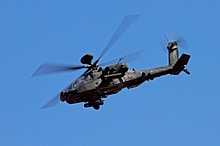
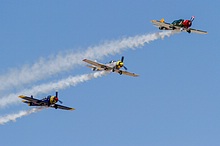





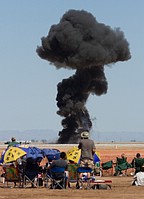


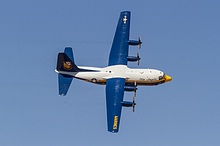
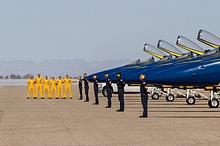
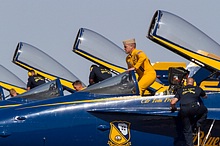
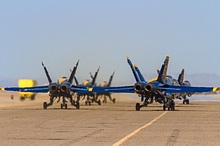
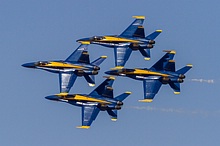
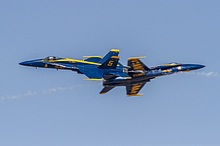
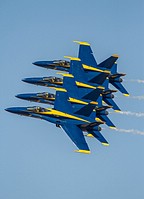

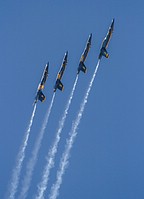

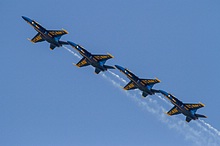
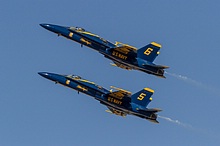
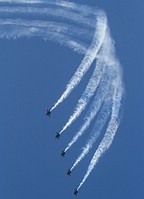

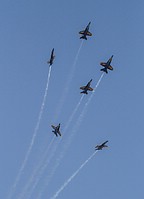

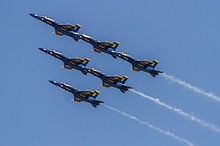
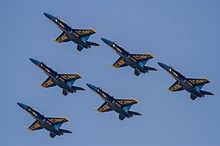
 Back to Index
Back to Index